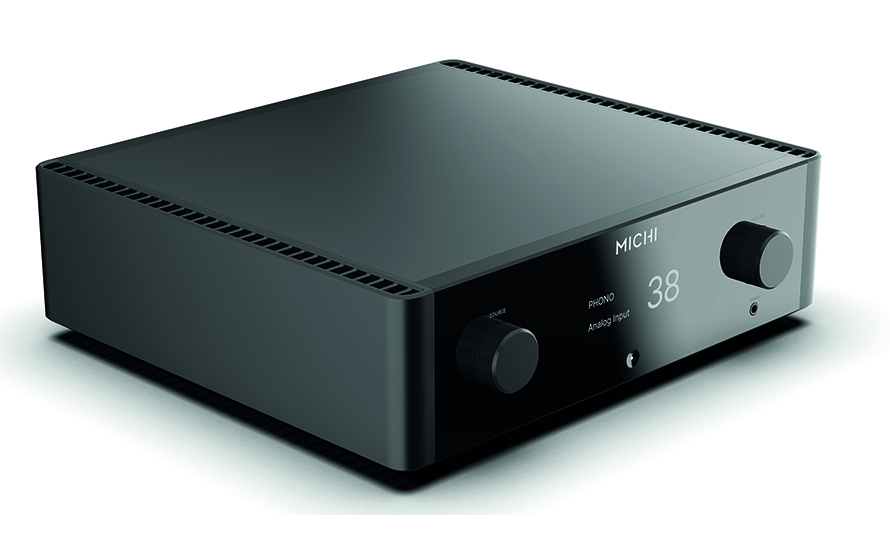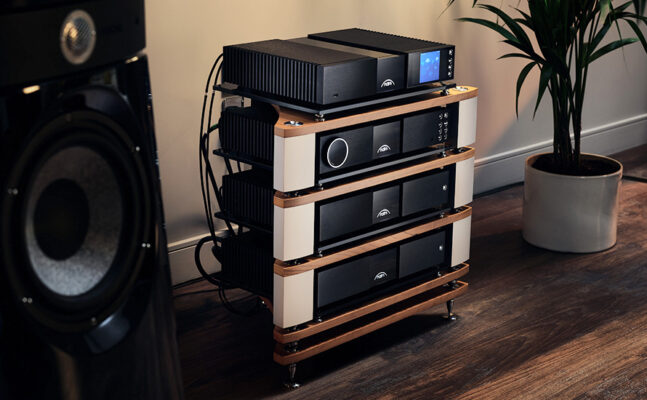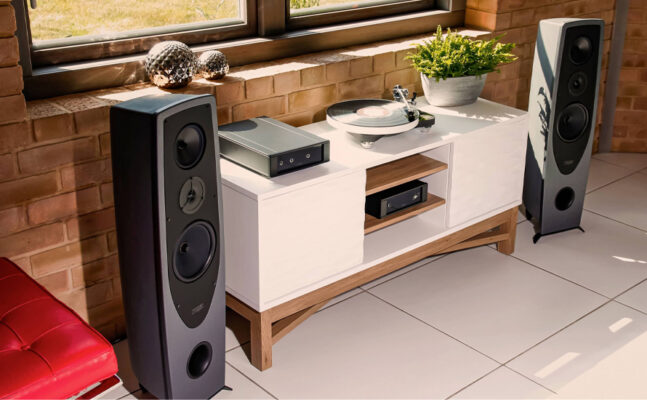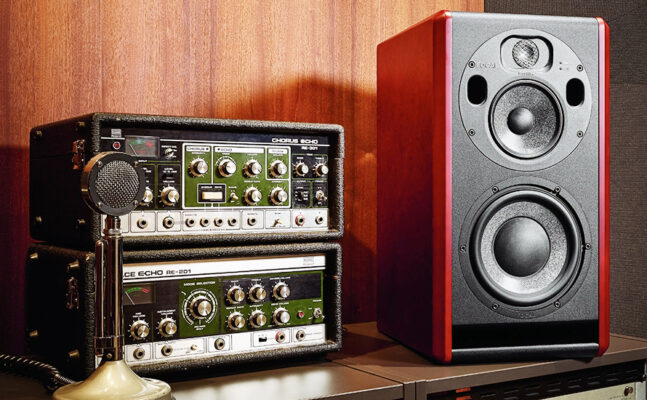Michi. In Japanese, it is both a meaningful word as well as a personal name. Though just five letters and relatively easy to pronounce – “mé–chée” it carries a rich meaning. The direct translation of Michi would be – route; way; or path and it conveys the idea of purity, righteousness, or proper course. Knowing the meaning of Michi brings greater understanding of why it is the name given to the flagship audio product series from the long-established Japanese manufacturer – Rotel (est. 1961). Rotel’s flagship Michi series of products can be seen as ‘a path’ to deliver the listener the highest level of music purity…the proper course to musical enlightenment. Introduced in 2018, the Michi flagship series is hailed by the company as delivering: ‘acoustic elevation; sonic evolution; and visual perfection’.
Integrated amplifiers, especially full-featured models have become all the rage in most recent years, as technological and engineering advancements have allowed for smaller components with increased performance. Just as computers have gotten smaller and more powerful with time, audio components can be designed now with smaller footprints, without compromising audio performance. In fact, improved circuit boards, allowing for shorter pathways and optimization interconnections between modules, it is possible to even improve performance though bringing together function within a single enclosure. Cost too is a key consideration. An audio component’s casework is a significant portion of the overall component cost, even more so with top-tier or flagship lines. Hence, strategically integrating two or more components, within a single case, provides an opportunity to reduce cost. A properly designed and optimized integrated amplifier no longer needs to mean a compromise in performance over separates. This is just the reason that integrated amplifiers need to be considered even when pursuing high-end components. This is just the reason why the Michi X3 Series 2 Integrated amplifier caught my attention; being not only a preamplifier and power amplifier in a single box but also having a digital-to-analog converter (DAC); moving magnet (MM) phono pre-amplifier and a headphone amplifier.
Michi most recently raised the bar on the performance of several its models, introducing its Series 2 (S2) range in April 2023. Within the line-up of Michi models, an S2 applies to three of models. First there is the new Michi X3 Series 2 Integrated Amplifier, then the Michi X5 Series 2 Integrated Amplifier, and finally, the Michi P5 Series 2 Preamplifier. In addition to these Series 2 models, Michi continues to include the S5 Stereo Amplifier and the M8 Monoblock Power Amplifier within its stable of products. The Series 2 brings several updates and enhancements to the Michi models. In particular, the X3 S2 has been updated with 90 component upgrades, including a new 8-channel ESS SABRE ES9028PRO 32-bit 768kHz digital-to-analog converter (DAC) and reengineered power supplies and audio paths to reduce noise and distortion.
Technical Features
The X3 S2 Integrated amplifier incorporates a highly regulated power supply with Michi’s own custom-designed toroidal power transformer, as well as custom slit foil capacitors. The low impedance power supply is designed to ensure ample power to ensure it can comfortably and faithfully deliver needed power. The printed circuit boards (PCB) include Symmetrical Circuit Traces to ensure precise music signal timing and metal film resistors and polystyrene, or polypropylene capacitors are also employed in the important signal paths.
The power amplification is Class A/B amplifier with a stated maximum power output of 350 Watts/channel (4Ω) or a continuous power output of 200 Watts/channel (8Ω). Frequency response exceed the audible spectrum with a low total harmonic distortion (THD) rating of < 0.008 %, accompanied with intermodulation distortion of (60 Hz:7 kHz, 4:1) < 0.03 %. The signal-to-noise ratio of both line and digital inputs is 102 dB (IHF “A” Weighted), while the phono input is rated as 80 dB SNR. Channel separation is rated as > 55 dB. The preamplifier output (pre out) level has a maximum level of 1.9 V, with 100 Ω output impedance. The input sensitivity / impendence ratings are: (RCA): 340mV / 100kΩ, (XLR): 540mV / 100kΩ and (MM Phono) 5.2 mV / 47kΩ. The 32-bit ESS Sabre 8-channel DAC is capable via SPDIF LPCM (Coax/Optical) of 24-bit / 192kHz, while via USB Class 1, up to 24-bit / 96kHz and USB Class 2, up to 24-bit / 384kHz, providing support for DSD & DoP and MQA & MQA Studio, as well as Roon Tested. There is also wireless aptX HD Bluetooth source support.
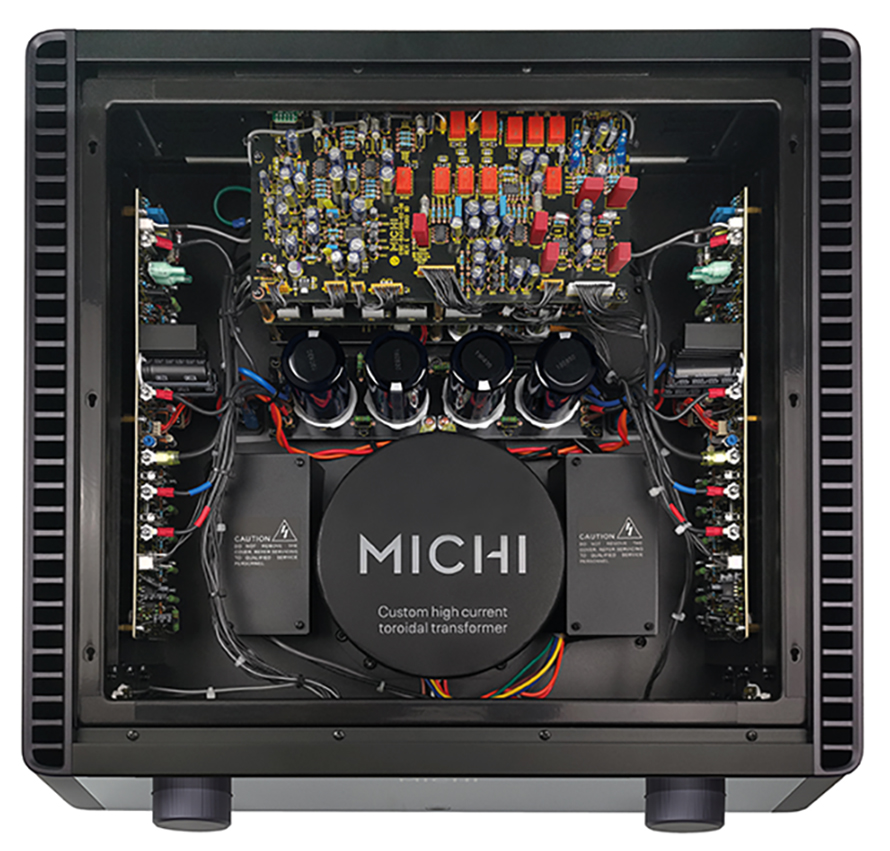
Construction & Build
The Michi X3 S2 is: 485 mm (W) x 150 mm (H) x 452 mm (D) / 19″ x 6″ x 17 3/4″ with a weight of 28.9 kg / 63.7 lbs. The dimensions and weight don’t lie, the X3 is no lightweight, to the contrary its big and heavy, which gives confidence in its power capability, yet despite its stature, the X3’s simple lines and accoutrements – just a pair of knobs (volume/source), power button, headphone socket and inconspicuous IR sensor, present a very contemporary design aesthetic. The eye-catcher is the Michi X3’s very attractive and useful large white-on-black LCD information display. The X3’s chassis is curved on all four upright corners, which serves to perfectly soften the rather imposing squared form. Looking down at the top of the X3 gives you the only glimpse you’ll get of the heatsinks – the ribs effectively concealed by the X3’s smooth exterior panels. Like the Model T, the X3 S2 comes black and black only with a micro bead-blasted finish that is almost suede like to the touch. The overall build is exemplary for a product at this price point. Form and feel of the Michi X3 S2 exudes an understated elegance and are fully in keeping with its flagship status. This integrated comes with a svelte IR full-function wand remote that is exquisitely built that was a pleasure to use. A double box contains a microfiber slipcover for the X3, along with IEC power, USB-Type B and Ethernet cables.
Functions and Functionality
The Michi X3 S2 was a pleasure to use, with simple and clear functions that the remote allows full and easy access to, while the large display allows you to also see all options clearly. Inputs can be given custom names and the display can be set to provide dB Peak Power Meter or a Frequency Spectrum Analyzer (8, 12 or 16 bands), as well as Status. There are also Bass and Treble controls, along with a Direct Bypass. There are settings for Power On volume, Balance, Auto Mute and Signal Sense power on. There is also an HT Bypass. On the back you will find RCA analog inputs for CD, Tuner, Aux, and MM Phono, as well as one pair of Balance In (XLR) inputs. Two mono sub-out RCA jacks are provided along with stereo RCA pre out jacks. Digital inputs include: SPDIF (3 optical, 3 coax) and both Network and 2 x USB jacks. There is also an RS232 service port. A master power switch and 12V triggers (in / out) are also out pack along with 8 (2 stereo sets) of high quality, five-way binding posts that are intended to separate Low and High frequency hook-ups. Finally, an IEC mains power socket allows for experimenting with aftermarket power cables.
Setup / Use
I placed the Michi X3 S2 atop my Quadraspire SV3T rack with a Pangea AC-9 power cable substituted for the OEM zip-cord supplied. The digital source was my Rega Apollo as a CD transport connected via SPDIF coax; while I also used my Bryston BR20 streamer / DAC connected to the Michi X3 S2 via XLR and set at its unity gain (0). Qobuz as well as Tidal HiFi were used for streaming sources. The analog source used was my Scout 1.1 / Dynavector 10×5; with my Gold Note PH-10 & PSU-10 phono amplifier used for comparison. Though I did start the evaluation with my Focal Electra Be II standmount loudspeakers I did most of my listening with my Dynaudio C2 Signatures.
Listening
I began with a level-matched A / B comparison against my long-term cost-effective reference, the Rega Elex-R integrated. Within a couple minutes of the first swap-out, I was convinced that the Michi X3 S2 sat clearly in a higher league; relaying finer detail, increased bass definition, greater openness, and overall composure. Music through the X3 sounded more relaxed and freer flowing, with clearer more nuance sound that demonstrated how the Michie X3 can step out of the way of the music.
I recently discovered the track (Looks Like) Somebody Got Ahead Of Schedule On Their Medication from Charlie Hunter’s album Everybody Has A Plan Until They Get Punched In the Mouth. Yeah, a mouthful of a track and album name but this is one seriously good bluesy track that can sound spectacular on a capable system. The Michi X3 S2 delivered the opening kick drum hits with amazing density and weight. Thunderous was how I described it in my listening notes. Not only were the strikes concussive but they relayed the shudder around the drum hits in a well-controlled and voluminous manner. An iron fist in a velvet glove would apply here. Though the sheer power of the percussion was attention grabbing, I was also very impressed with the crisp attack of the cymbal hits and the preservation of natural shimmer and sustain around the treble notes. Brass tones were lively and accompanied by authentic timbre that convincingly constructed a captivating illusion of a live performance.
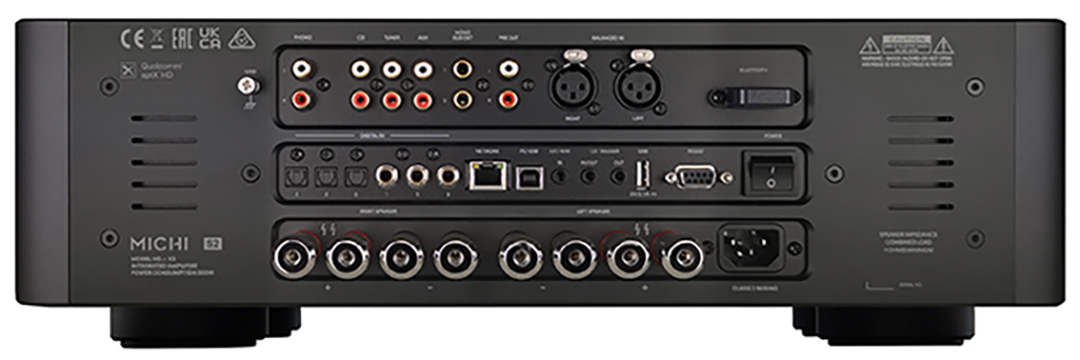 The fabulous Quebec music artist, Dominique Fils-Aimé, with her title track Nameless was nothing less than room filling with the Michi X3 S2. Her voice was graceful and silky smooth via the Michi absent of brittleness or oversaturation. Not only was Dominique’s lead vocals clear and focused but the background vocals were also very well defined, separated in space, and easily interpreted individually. The embodied sense of these voices was something I took note of, as the Michi in relaying detail does not forego the need to produce a convincingly lifelike rendition. The soundstage produced was both remarkably wide and open sounding with both focus and dimension obvious. Within the soundstage, images portrayed seemed suspended, as if on an invisible string, with dimension and relief; the X3 S2 demonstrating a capacity not only for producing a sense depth and width but also height. The sound was airy yet had a slight lean to the warm. On Dominique’s track Birds from the same album, I was most impressed with the flesh like quality of the hand claps; the X3 drawing out the clap and avoiding any distracting sharpness or etch. This same naturalness applied to the percussion and the flapping wing effects which are so well captured on this track.
The fabulous Quebec music artist, Dominique Fils-Aimé, with her title track Nameless was nothing less than room filling with the Michi X3 S2. Her voice was graceful and silky smooth via the Michi absent of brittleness or oversaturation. Not only was Dominique’s lead vocals clear and focused but the background vocals were also very well defined, separated in space, and easily interpreted individually. The embodied sense of these voices was something I took note of, as the Michi in relaying detail does not forego the need to produce a convincingly lifelike rendition. The soundstage produced was both remarkably wide and open sounding with both focus and dimension obvious. Within the soundstage, images portrayed seemed suspended, as if on an invisible string, with dimension and relief; the X3 S2 demonstrating a capacity not only for producing a sense depth and width but also height. The sound was airy yet had a slight lean to the warm. On Dominique’s track Birds from the same album, I was most impressed with the flesh like quality of the hand claps; the X3 drawing out the clap and avoiding any distracting sharpness or etch. This same naturalness applied to the percussion and the flapping wing effects which are so well captured on this track.
Not to be cliché but I would have to say the term musical would apply to the Michi X3 S2. However, I only say this because of its proficiency in relaying music with a consistently enjoyable manner, and across a wide spectrum of music genres and recording qualities. However, the X3 is also truthful and avoids overt embellishment. It is not mushy or romantic and its also not analytical in any sense but rather serves up definition, detail and clarity in spades while preserving the sense of ease, tonal richness, and dynamics.
Listening to the track Creep from Daniela Andrade’s Cover Vol. 1 album, the Michi’s grip and focus on the track was most apparent, and the vocal delivery was undeniably vivid, her voice and phrasing being nothing less than stunning. There was not smoothing over of essential and desired details yet the Michi X3 S2 does most gracefully and adeptly smooth that which is most abrasive and egregious within a recording and / or the upstream playback chain. On this same track, guitar strums were spirited and dynamic, tight, and impactful. Zack Bryan’s track I Remember Everything featuring Kacey Musgraves, has some inherent dryness within the recording, perhaps a combination of the mic and perhaps the recording chain but most noticeable on the male vocalization of Zack. Here, the Michi X3 S2, relaying the dryness but also avoided emphasising it, diverting focus somewhat away from the recording and towards the music.
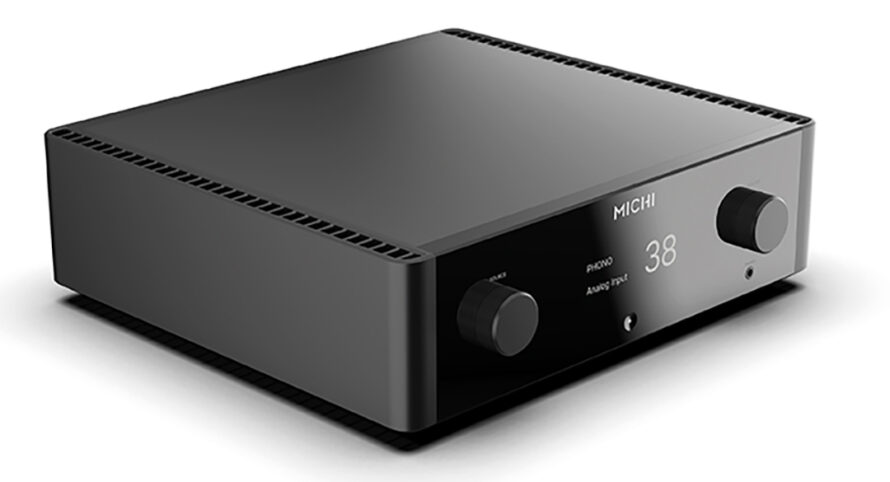
I spent time assessing the Michi X3 S2’s built-in 32-bit ESS Sabre DAC using my Rega Apollo as a transport. I can assure you the included DAC is no afterthought but a very capable implementation, able to provide generous soundstages, with substantial detail, distinct images, and clear element separation. Across the audible frequency the Sabre DAC came across as very even handed, portraying a hint of warmth while not drawing attention to any sub-band. The bottom-end was full and rich, favouring weight and fullness over exacting definition. The mids were natural, without a sense of forwardness and seamlessly blending into a smooth and polite top end. Only in back-to-back comparison with my BR20 DAC, did I find the ESS Sabre DAC to be slightly less transparent and revealing of detail with less bass control and articulation on the lowest notes; however, the X3 S2 having the edge on bass fullness.
The Michi’s integrated MM phono stage was a strong performer, delivering vinyl with characteristic warmth, texture, and harmonic colour. Bass had richness and texture, the midrange was even-handed and well developed, with a clear though slightly modest treble presence. Putting the X3’s phono stage against my Gold Note PH-10 / PSU-10 stage, I did find the Gold Note was able to extract more detail from the grooves, with increased tonal complexity, greater dynamic variance and upper treble presence. Mind you the Gold Note pair is over $4,000 CAD vs. $6,799.99 CAD for the Michie X3 S2 integrated with phonostage. Hence, not a fair comparison but did allow me to confidently conclude that the X3 S2’s phonostage is very capable and should well support turntable setups at up to half the price of the X3 S2 itself.
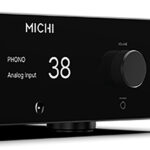 I used my Grado 325e and a borrowed set of AKG K7XX (thanks Anthony) to assess the headphone output on the X3 S2. The headphone amplifier was very quiet, providing black backgrounds with a relaxed and composed personality that ably separated elements within the mix. The laid-back presentation complemented my Grado’s beautifully, keeping their forward mids and treble in check. Power was always abundant to reach obscene levels with clarity and the presentation was able to hold my interest as well as provide a comforting listening experience.
I used my Grado 325e and a borrowed set of AKG K7XX (thanks Anthony) to assess the headphone output on the X3 S2. The headphone amplifier was very quiet, providing black backgrounds with a relaxed and composed personality that ably separated elements within the mix. The laid-back presentation complemented my Grado’s beautifully, keeping their forward mids and treble in check. Power was always abundant to reach obscene levels with clarity and the presentation was able to hold my interest as well as provide a comforting listening experience.
What I concluded about the DAC, phonostage and headphone output of the Michi X3 S2 was that each of these modules on their own were of high quality. I’m confident that most will find them more than enough; however, those seeking to get the absolute most out of their X3 can be assured that this amplifier can well deliver on the goods even when paired high-end stand-alone components.
Does the Michi X3 Series 2 Integrated Amplifier do the brand justice? Most definitely! It’s a superbly designed and built integrated amplifier, with great attention to detail. The X3 provides a broad feature set without compromising on the quality of the parts; delivering performance that goes beyond the sum of its parts. It has a neutral tonal balance with a dash of added warmth, smoothness, and fullness that allows it to work wonders across all music genres, while providing source forgiveness combined with great insight and excitement. As the name Michi implies, the Michi X3 S2 Integrated Amplifier provides a righteous way to musical enlightenment. A top-notch integrated amplifier that is strongly recommended.
GENERAL INFORMATION
Price : 6 999 $
Warranty: 5 years, parts and labour
Distributor : Kevro International Inc.,
T.: 905.428.2800,
https://www.kevro.ca/ ;
https://www.rotel.com/en-ca

